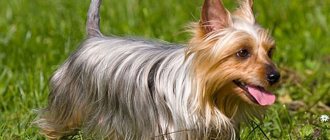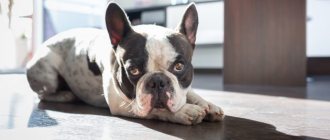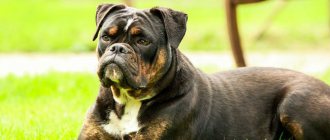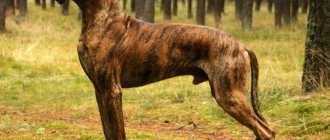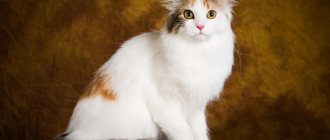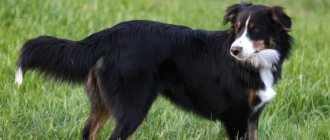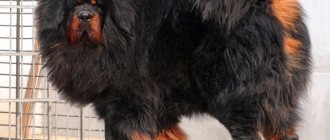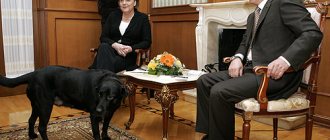History of the American Bulldog breed
Ambul has rightfully earned his honorary “title” - the bulldog of bulldogs.
The breed is unique in that its representatives managed to preserve their original characteristics and appearance from the 15th century to the present day. Bulldogs first appeared on the lands of England, where they were bred from Molossian dogs to organize bullfights. Back then, dogs cost their owners a pretty penny, since their courage and remarkable strength determined the outcome of a fight with cattle. The offspring of champion ambulae, who repeatedly won in fierce battles, were especially valued. The value of the breed was also explained by the ability of its representatives to endure any pain. Breeders often held demonstration “performances”, during which they brought dogs to a state of bestial rage and demonstrated their endurance. Such performances had a sad outcome: ambuli often died, but this in no way detracted from the popularity of the breed or the amount that buyers were willing to pay for the future champion.
White American Bulldog
American Bulldogs were used as blood sport animals until the early 19th century. After the signing of a law that prohibited bull baiting and dog fighting, the price of ambuls dropped sharply. Bulldogs were forced to be kept in the yard, since their cruelty and indomitable temperament often posed a danger even to the owner. They forgot about the breed for some time, since it was not distinguished by anything other than endurance: neither its cute appearance, nor its docility, nor other characteristics.
With the popularization of exhibitions, the ambul again attracted the attention of dog breeders. Wanting to make dogs more suitable for show, geneticists added pug blood. This experiment took thirty years and ended very successfully: the new specimens were smaller in size, more correct in proportions and calm in disposition. Soon bulldogs were divided into separate breeds. Kennel clubs were organized for them, which registered puppies and documented their pedigree. This is how the English bulldog arose, which earned the glory of the country’s national symbol.
It is worth noting that the history of the breed was not limited to this. At the beginning of the 18th century, a tense economic situation reigned in England. The prison cells were overcrowded with debtors who did not have enough money to pay the required amount. The government made a cunning move by promising amnesty to those prisoners who would go to settle the new colony in Georgia. Few prisoners reached American shores, but this was amply compensated by the movement of working-class people who hoped to start a new life and escape their hardships. Together with them, people brought their most valuable “property” - real bulldogs, which at that time were still involved in bull baiting and retained their unbridled temper.
American bulldog puppy
At first, the colonists had a hard time: the wild lands needed clearing and constant protection from warlike Indian tribes, the Spaniards and the French. Ambul unexpectedly showed himself to be a reliable and devoted watchman who could be relied upon. Thus, thanks to their athletic build, endurance, hard work, courage, intelligence and excellent sense of smell, bulldogs turned out to be indispensable companions in the wild lands of America.
Then farmers did not attach importance to the appearance of the ambul - a large dog with a massive muzzle and strong paws. The breed was valued not for its appearance, but for its working qualities. Attempts to include Southern bulldogs in the American Kennel Club (AKC) list remained unsuccessful for a long time. Preference was given to foreign breeds, and “natives” from the colonies were considered ordinary and unworthy of attention.
In addition, the bulldog breed was already registered with the AKC, and southerners would have to think of a new name to avoid confusion when popularizing the bulldog in the United States. Georgian large, exhibition, working, southern white, old - all these names referred specifically to the ambul. Until the middle of the 20th century, he was not registered by any canine organization and could not boast of an official pedigree.
Only by the 60s the name “American Pit Bulldog” was assigned to the breed. At the same time, the first standard was presented to everyone's attention. Soon, ambulies were registered by most cynological organizations. Dog breeders were captivated by her impressive appearance combined with her impeccable service skills. Increasingly, bulldogs were bred for military departments and police stations. In comparison with other dogs, ambuli were distinguished by endurance, prudence and incredible sense of smell, inherited from distant ancestors. Representatives of this breed were also used during the search for survivors of major disasters.
Soon the American bulldog won the love of not only America, but also all of Europe. Even Russia during the “roaring nineties” responded to this canine trend: increasingly frightening-looking dogs appeared on city streets, ready to rush to the defense of their owner at any moment. The breed is still popular today. At the same time, its name - American Bulldog - does not scare away potential dog owners with unpleasant associations with bull baiting and dog fighting. On the contrary, the massive and terrifying dimensions of the animal give a person indestructible self-confidence.
Description and history of the breed
This breed is often compared to its closest relative, the English Bulldog, and in rare cases may be called the Old English Bulldog. The uniqueness of representatives of this breed lies in the fact that they have not changed their external characteristics at all and have retained all the features of their English ancestor. These dogs are descended from the ancient Assyrian and Egyptian baiting dogs that first appeared in Greece and later spread to Europe. In medieval England, these dogs were especially popular as they were involved in bloody bull-baiting. Later, with the appearance of the breed in the vastness of America, this Old English Bulldog turns into a farm dog and does an excellent job of guarding houses and herds, and sometimes even transports various loads and babysits small children. In a word, very versatile dogs, if not universal.
The American Dane is far from being a lap dog, and its stern appearance speaks to this. They are also called the symbol of the US Marine Corps, and depending on the state, the full name of the breed was extremely different. The American bulldog began to be called only 15 years ago. However, many cynological organizations still do not recognize the Great Dane breed, thereby affecting its popularity in the modern world.
Appearance of an American Bulldog
The Ambul is a large dog.
Variability is a key feature of this breed. Its representatives differ from each other in many characteristics. Despite the existence of two lines - classic (Johnson) and standard (Scott), the appearance of modern dogs combines features of both. If we consider each type separately, it can be noted that Johnson's ambullies are more squat and larger than they resemble their counterparts - English bulldogs. Standard type dogs are more similar to the American Pit Bull Terrier. According to the FCI standard, the height of the ambul at the withers should be 55-70 cm (for males) and 52-65 cm (for females). As for body weight, it reaches 32-54 kg and 27-45 kg, respectively.
"Standard" type of American Bulldog (Scott line)
"Classic" type of American Bulldog (Johnson line)
Head and skull
American Bulldog Johnson line
The American Bulldog's head is large in size and proportional to the dog's body. The slightly rounded and wide skull forms a high forehead and a moderately pronounced occipital protuberance.
Muzzle
Its appearance depends on what type your ambulatory is. The Johnson line is characterized by a square and smoothly contoured muzzle with a well-defined stop. Representatives of the Scott line have a more wedge-shaped muzzle, while the transition from the forehead to the nose is less pronounced. At the same time, classic ambuli have a shorter muzzle (up to 30% of the length of the skull) in contrast to standard specimens (up to 40%). Deep folds are characteristic of Johnson's Bulldogs. The large nose with wide nostrils is colored black or brown (the first is more preferable). Dark lips fit tightly to the jaws.
Ears
The American Bulldog's ears are medium in size and set high on the forehead. Can be hanging or standing. The shape is predominantly triangular, but “envelope” or “rose” options are allowed. It is not recommended to crop ears at any age.
Eyes
Small round eyes are set straight and wide. Their color varies from nut to dark brown, with dark shades still being a priority. The eyelids fit tightly and are distinguished by dark pigmentation up to the full “rim” of the eyes. Unpainted areas are allowed in individuals under two years of age.
Jaws and teeth
The American Bulldog's jaws are quite wide. In this case, the lower one moves forward slightly beyond the line of the upper one, forming a so-called dense snack or snack with waste. Please note that in both cases the teeth should not be visible if the mouth is closed. The canines are set wide apart in the jaw, while the incisors form a straight line. Large and healthy teeth are preferred. The first two premolars may be missing.
Neck
The muscular and powerful neck is set at an angle of 45 degrees relative to the body. It has a well-defined scruff.
Frame
The American Bulldog has a slightly elongated body. Half the height of the dog at the withers is equal to the depth of the chest. The girth of the skull and neck is the same, while the length of the latter should exceed the length of the head.
Tail
It has a wide base and gradually tapers towards the tip. The maximum compliance with the standard is considered to be a tail that reaches the hock joints.
Forelegs
Set wide and parallel to each other. The shoulders and forearms are notable for their well-developed muscles. Elbows point back. The forelimbs turn into strong, rounded paws. Short fingers tightly clenched.
Hind limbs
The distance between the hind legs is much wider. The hips and shins of the ambul are characterized by prominent muscles. The angle of the limbs is moderate. The paws have a slightly elongated shape, making them look longer and narrower than the front ones.
Face of an American Bulldog of the Johnson Line
Scott line American Bulldog face
Movement style
The movements of the American Bulldog are powerful and clearly coordinated, reminiscent of a free trot.
Coat
The length of the hairs of the coat should not exceed 1.5 cm. They fit snugly to the dog’s body and have a healthy shine.
Color
Ready for the holiday!
Most often, the coat of ambulets has brindle, white-brindle, white-red and white colors. Black, black and tan, merle, blue are allowed, but only if these colors include spots of white. In this case, the marks must cover at least 10% of the body. Please note that at dog shows it is the white color that is most valued.
The defects of the American Bulldog breed include the following:
- tail with a crease, lying on the back, in a corkscrew;
- yellow, green or gray color of the iris;
- bulging eyes with drooping eyelids;
- gray pigmentation of the nose;
- poorly developed muscles;
- direct jaw bite;
- sharp narrowing of the muzzle;
- depigmentation of the eyelids;
- heterochromia.
Please note that a defect is any deviation from the standard. There are also disqualifying defects. Among them:
- excessive cowardice or aggressiveness;
- failure of the male dog's testicles to descend into the scrotum;
- blue eye tint, asymmetry;
- long coat;
- scissor bite;
- uneven line of incisors;
- jaw asymmetry;
- deafness and blindness.
Description of the breed: interesting points
Today, the American Bulldog is considered a family dog. At the same time, outwardly they remained as powerful as they were a couple of centuries ago. They have well-developed muscles, a deep and wide body and a square-shaped head, rather large in relation to their height. The muzzle is short and also has a square shape. Snacking is also typical for Bulldogs.
Males are heavier than females. This proportion of height and weight gives representatives of this breed a heavy and clumsy appearance. But this is not true at all. The ambulatory's movements are light, springy and fast. He is capable of high speed.
- Height: 55 - 68 cm for males, 50 - 63 cm for females;
- Weight: 35 - 58 kg for males, 28 - 45 kg for females;
| Characteristic | Description |
| Wool | short, tight-fitting, shiny, no more than 1.5 cm long; |
| General | dexterous, hardy, strong, unpretentious, smart; |
| General form | a dog of average or above average height, athletic build, elongated body, large, wide head, short muzzle; |
| Nose | large, with wide, open nostrils, with black pigmentation; |
| Ears | hanging, medium size; |
| Eyes | from dark brown to light walnut; |
| Neck | powerful and muscular; |
| Lifespan | 10-15 years; |
| Contents in the apartment | suitable for keeping in an apartment in the presence of physical and mental stress; |
| Fits | experienced owners or beginners who are ready to devote a lot of time to education and training. |
Photo of an adult American Bulldog
American Bulldog Personality
Ambul is an ideal option for those who are looking for a brave, intelligent and selfless companion. The bulldog will walk with its owner through fire, water and copper pipes. The main thing is to let the dog understand that in your duet the role of leader is not assigned to him. The breed is not suitable for weak-willed people who cannot devote enough time to raising a pet. Don’t forget that the American Bulldog tends to dominate and defend its rights, which is why it needs correct socialization. Otherwise, the dog will perceive any living creature as a potential threat and show aggression.
American Bulldog with a child
The menacing and impressive appearance of the ambul hides friendliness and sociability. Representatives of this breed show incredible loyalty and devotion to the family in which they live. In critical situations, the bulldog will protect its owner to the last drop of blood. Be prepared for sudden displays of love when 40 kilograms of puppy affection settles on your lap - and this is not so easy to withstand, by the way! American Bulldogs get along well with children and happily take part in games. However, be careful: the dog does not always understand that it is superior to children in strength and size, so it may accidentally fall on the child.
The breed is famous for its guarding qualities. Ambuli have excellent hearing and sense of smell, so not a single thief will be able to sneak into protected possessions. Often the dog puts on a show of his strength. If this does not stop the villain, the bulldog fearlessly rushes into battle, protecting not only the property entrusted to him, but also the people he loves.
In times of danger, representatives of this breed remain calm and skillfully build battle tactics. They cannot be distracted by false maneuvers and feigned threats. American Bulldogs are wary of strangers, even when close to their owner. It may take them quite a while to get used to the new person.
Ambuli have high intelligence, which becomes a problem in certain situations. Even a puppy can be smart enough to open a door or jump onto a windowsill where there are potted houseplants. And if the American Bulldog is bored, then beware: the dog will go as far as completely destroying the apartment in an attempt to throw out the accumulated energy.
Let's go for a walk
Don't forget that your pet needs daily exercise. Go for an hour-long run in the park, and don't forget to grab your dog's favorite toy. Ambul will appreciate this and, upon returning home, will happily fall asleep at the feet of his owner, where he will spend the rest of the day. It is worth noting that American bulldogs are excellent walking companions. With proper training, their poise and calmness will eliminate the need for you to keep the leash taut.
If you are planning to take a bulldog as a companion for your second pet, give up your idea. Representatives of this breed do not get along well with animals, and especially with their relatives. American Bulldogs do not tolerate competition, and having a dog of the same gender will only make the situation worse. In the absence of proper upbringing, the ambul is capable of injuring or killing another pet, regardless of size. Don't forget that this breed was originally bred for bloody bullfights. Pronounced hunting instincts can provoke a dog into a chase, which in most cases has a sad outcome.
Features of character and behavior
There is a widespread myth about the character of representatives of this breed, which is still firmly in the heads of the majority of the population of the CIS countries. It lies in the fact that ambulies are uncontrollable and vicious dogs that are unable to get along with other animals and children.
And here we should not deny that each representative of the species contains a gene pool of truly harsh ancestors. But at the same time, you need to look at situations from a realistic angle.
- The character of a dog is partially predetermined by nature and has features that are almost impossible to change . But its behavior with people and animals depends on the upbringing instilled by the owner.
- Ambuli can be aggressive and disobedient, but only if they have been poorly or poorly trained. Modern representatives of the breed are willful, but patient. They are wary of strangers, but are friendly towards members of their owner's family. Bulldogs remember good and bad, so they need to be raised correctly, avoiding aggression and, especially, causing physical harm.
- Representatives of the breed often have a negative attitude towards other dogs. This is not considered a deviation; moreover, this factor is stated in the official characteristics, confirmed by dog handlers. Therefore, it is imprudent to take a bulldog into a house in which a dog of another breed already lives. There is a high probability that animals will conflict with each other. If a fight occurs, the bulldog is 99% likely to emerge victorious, and his opponent will be left with injuries.
- You cannot leave a small child with a bulldog . The younger the baby is, the higher the likelihood that his behavior will cause a negative reaction and aggression in the dog.
Advantages
- These dogs are excellent guards and devoted companions. They are truly capable of protecting their owner from any number of offenders. The physical form of ambulees allows them to compete even with tall and strong men. Therefore, the main advantage that bulldog owners feel to the fullest is safety.
- Representatives of the breed are capable of tender feelings; they can be affectionate and even flexible . This is not a plus that manifests itself in all dogs without exception, but it takes place among pets who receive love and care from their owners. Ambuli are sensitive, they are able to understand the emotions and intentions of other animals and even people.
- And finally, this breed is absolutely unique. She became the prototype for many popular fighting species (including the American pit bull). The physical abilities of the representatives of the breed are still considered unique, despite the fact that many strong and hardy dogs have been described in cynology.
Flaws
There are only 3 disadvantages, but each of them deserves special attention:
- Ambules should not be owned by people who do not have experience in keeping and training fighting or hunting breeds. These dogs feel insecure and lack of control over the situation. They will not listen to a person who is afraid of them or does not understand at all what he needs to do.
- American Bulldogs need physical activity . You need to constantly walk with them or let them go outside alone (if the area is fenced). Training should also be regular and long-lasting. Without proper physical activity, ambulans become aggressive and completely disobedient.
- There is always a possibility of running into a “bad” puppy (especially when trying to save money). Many breeders are not experienced enough to breed Ambules. Some people try to cheat and sell a non-purebred dog. Breed standards are too vague, which allows scammers to profit from naive buyers.
Ambul is not a pet for everyone. You need to prepare for a long time to buy and raise this dog.
Education and training
Developed intelligence and independent character are good reasons to start raising an ambulant as early as possible. First of all, the puppy must realize the main truth: the owner’s word is a law that cannot be broken under any circumstances. Stop the slightest attempt by the bulldog to growl and grin at your family members, but under no circumstances raise your hand to the dog! American Bulldogs do not take kindly to cruelty and may become angry with you in the future. Firmness, perseverance and patience are the three pillars on which the proper upbringing of a pet rests.
Waiting for the owner
Don’t forget that self-discipline is the weak point of ambullies, so it can take more than one month to develop habits. First of all, start creating a daily routine. To do this, take your ambulant for a walk twice – in the morning and in the evening. Soon your pet will understand that it is necessary to relieve itself exclusively on the street. This way you will avoid unpleasant “incidents”.
During a walk, do not allow the ambulant to pull on the leash, rushing forward. In the case of a puppy, this can look funny: the stocky baby sniffles from tension, wanting to speed up his pace despite the efforts of the owner. However, rest assured: when an obese dog weighing almost half a centner appears in his place, this will create certain inconveniences. The dog should walk next to you - and nothing else.
Don't let your pet jump on people with its front paws. It is very difficult to maintain the impressive dimensions of an American Bulldog (especially for children). In general, it is not recommended to allow the ambulum to exert force. Keep him from fighting with other dogs or cats. Don't even bark or growl in their direction.
Price and choice of puppy
By buying a puppy, a person acquires a friend and family member for the next 10-15 years. Therefore, you need to approach the choice of a puppy responsibly.
It is better to buy a puppy from a trusted breeder or kennel. To do this, you can find a breed forum or a breed group in your city (or nearby cities) and communicate with the owners of ambulets, read their reviews. One litter can have puppies with completely different perspectives and nervous systems. Therefore, the choice must be made based on future plans. If you plan to take the puppy “to the sofa,” then you can choose a pet-class puppy, the cost of which starts from 8 thousand rubles. If you plan to further breed the dog and show it, then you need to purchase a breed-class puppy (from 15 thousand rubles) or a show class puppy (from 25 thousand rubles).
Read What is the difference between a husky and an Akita Inu: choosing a puppy, photos of mixed breeds
It is also necessary to test the puppy’s nervous system before purchasing. To do this you need to do the following:
- Clap your hands loudly. If a puppy runs away squealing and hides, then most likely he will grow up to be problematic and cowardly.
- Sit on the floor and try to interest the puppies with a toy. If the puppy looks at the toy with interest or starts playing, then everything is fine. If he hides, then this again indicates that the puppy is a coward.
- Take the puppy and turn it over on its back. If he starts to break free and bite, it means he is choleric, and in the future he will grow into a very active dog that requires attention. If he looks thoughtfully and is in no hurry to turn over, then he is clearly a phlegmatic person.
- Examine the ears (they should be clean, without black discharge), eyes (there should be no strong discharge or “tear tracks”).
- Observe the behavior of the puppies and their activity. If a puppy is always eager to play with his brothers and sisters, bullies them, explores new objects and strangers with curiosity, then he will grow up to be very active and will need more physical activity. If he prefers to sleep, thoughtfully watch other puppies, and is slow, then he will grow up to be a domestic couch potato.
Care and maintenance
The American Bulldog breed is completely unpretentious in care. These dogs are prohibited from undergoing water procedures more than two or three times a year. It is enough to wipe the face as it gets dirty - and your pet will always look neat and clean. Ear sticks and cotton pads are suitable for these purposes.
Oh yeah! Refreshing shower
The only thing you will have to spend money on is a special brush for combing. During shedding, the American Bulldog leaves a lot of hair, so it is recommended to brush the dog at least once a week. If you don't have a brush at hand, a rubber glove will do just fine. Don't forget about the bulldog's claws. Sometimes long walks are not enough to wear them down. Use pruning shears to shorten nails every one and a half to two months.
However, your ambulant will be grateful not for pleasant spa treatments, but for daily active walks in the fresh air. Every feature of this powerful and noble dog has a craving for physical activity, so you should not deprive your pet of this joy. Every kilometer traveled will give your bulldog good health, and you will be in a great mood.
As for ambulant nutrition, it is recommended to use special dry food with a vitamin-mineral complex. Periodically dilute your dog's diet with dairy products and fresh meat. You should not treat your pet with “human” food, no matter how pitiful his eyes may look at you: this can negatively affect the bulldog’s well-being.
Observe the following rules:
- Don't make meat the mainstay of your diet. Remember that it must be balanced and include at least 30% protein.
- You should not often give your American Bulldog foods high in calcium and vitamins A and D. This negatively affects the dog’s skeletal system.
- Stick to frequency. So, puppies up to 4 months are fed five times, up to 6 months - four times, up to six months - three times a day. After this, it is enough to fill the bowl twice - in the morning and in the evening.
It is not recommended to include the following foods in your American Bulldog's diet:
- raw river fish (cooked is acceptable);
- legumes (peas, beans and others);
- minced meat (poorly digested);
- small tubular bones;
- fresh white bread;
- unboiled eggs;
- pork
Drinking water must be unboiled and clean.
Two brothers
American Bulldog Care and Training
The American Bulldog has a short, smooth coat that does not require special care. However, this breed sheds regularly, so frequent brushing at least once a week can reduce the amount of hair shed in the house. You can use a brush or rubber glove to groom your American Bulldog's coat.
It is recommended to bathe your American Bulldog only when necessary and not often.
Your American Bulldog's nails should be trimmed approximately once a week if they do not wear down naturally. Also, do not forget to periodically clean the ears, especially if the dog is prone to ear infections or suffers from allergies.
American Bulldogs are at their best when they are given a job to do. These dogs love to play with family members and roam around the property.
Regardless of the weather, the American Bulldog should get at least one hour of exercise per day. The American Bulldog can feel good in the house, but only with sufficient physical activity, only in this case the American Bulldog will be happy and healthy.
American Bulldogs are wonderful, loyal and brave pets who, if raised correctly, will never betray their owner, but, on the contrary, will obey him in everything and do everything possible to please him. Despite the fact that this is a very strong and strong dog, it is characterized by some indecisiveness. Being in a family, surrounded by people who love her, she turns into an affectionate and playful puppy, ready to give her love and tenderness to everyone who needs it. This is a wonderful breed that delights thousands of modern dog breeders with its good nature and pliability.
We advise you to read: American Akita dog breed
Representatives of the American Bulldog breed require constant supervision; they do not like loneliness and have a hard time enduring long-term confinement in a confined space. They should be raised by professionals who know how to instill good manners in such dogs from puppyhood.
Start training your puppy yourself as soon as he arrives in your home. Stop all actions that are undesirable for you in the future immediately. If something is “impossible”, then “it is always impossible.” For serious training - obedience courses - CD, OKD, UGS, etc. — it’s better to start no earlier than 7-8 months.
Bulldogs are dogs with delayed psychological development. At an earlier age, a bulldog simply cannot perceive a large amount of information at once. It is up to the owner to decide whether to train in a group or individually; each type of training has its own pros and cons. The only thing is, if you decide to study in a group, check whether you can then pass the standards for the course you have completed and receive an RKF diploma.
In your training, pay maximum attention to the commands that are most necessary for you in everyday life: “Come to me”, “Nearby”, “No”. Create your list and try to make their implementation automatic. You or your family members must train the dog personally if you want it to obey you and not the trainer.
Forceful training methods and electric shock are extreme methods of training inadequate animals; they are not applicable to puppies. You should not engage in obedience and protection training at the same time. First, strengthen your pet’s obedience skills and only after that (but not earlier than 12 months) begin defense training.
When your dog has completed an obedience course (OKD, UGS...) you can already begin protection classes. For an American bulldog, such training does not in any way mean “harassment”, of course, provided that the training is correct, but on the contrary serves as a kind of emotional “release”. During the training process, the dog must learn when and how it can act when the owner is in danger, and when it is necessary to simply carefully monitor what is happening without unnecessary aggression.
Having started training, many are surprised at how quickly their bulldog grasps seemingly completely new information, and what enormous potential this breed has in protective disciplines. In fact, everything is quite simple, the breed has not been in our country for so long and individual representatives of homo sapiens have not yet managed to spoil it with commercial “breeding”. Therefore, all the accumulated genetic experience of this breed sleeps soundly for the time being in your bulldog, but if the owner wishes to continue the development of the breed, even within the framework of his own dog, genetics will take its toll. Indeed, in the homeland of the American Bulldog, working qualities were much more important than appearance. And often this is why uninformed people wonder why they are all so different.
American Bulldog Health and Diseases
ambulette in protective collar
Despite excellent stamina and good health, ambuli are susceptible to certain diseases. Among them:
- eye problems (strabismus, entropion, cataracts);
- dysplasia of the hip and elbow joints;
- skin diseases and allergies;
- heart failure;
- congenital deafness;
- immunodeficiency;
- heart disease;
- epilepsy.
American Bulldog bitches often have difficulties during childbirth. However, you should not think that by purchasing an ambulette, you automatically become the owner of a sick dog. This breed remains active and thirsty for life until old age. The rest depends on your attention and timely treatment of your pet.
How to choose a puppy
Choosing an American Bulldog puppy requires a lot of attention. It is from this stage that acquaintance with representatives of the noble breed begins. One of them is destined to become your best friend, so be careful when purchasing an ambulette responsibly.
Ambule puppy with mom
Purebred American Bulldogs can only be found in trusted kennels. The breeder must provide upon request a certificate of veterinary examination of each puppy from the litter. The absence of one is a reason to think about whether you are going to take a healthy baby into your home? When examining puppies, the bitch must remain calm. If the dog is taken to another room or does not want to be shown to a potential buyer at all, this indirectly indicates its mental instability, which can be passed on to the puppies.
The ideal age of the baby is from one and a half to three months. The most sociable, cheerful and active toddler, by definition, is distinguished by good health. Shiny fur, a wet nose and perky little eyes are further evidence of this. If the bully cowardly tucks his tail or growls at an outstretched hand, refuse to purchase such a puppy: you will not be able to become friends for many years.
Appearance
Depending on the requirements for working qualities, the old-type Bulldogs were bred in accordance with certain selection schemes. Each “updated version” of the Bulldog received a new name and as a result, experiments led to the development of four main lines of the breed:
- Classic - a line that appeared thanks to the same John D. Johnson. The breeder used only purebred dogs that passed extremely strict selection for breeding. The descendants of such high-quality matings carried the almost primordial gene pool of the breed and were called the Johnson type. The main difference from other lines is the large weight of the dogs (55–60 kg).
- Scott type - working dogs, for which the best individuals were used, including the Classic type. Working skill - holding a wild animal. Scott Bulldogs are smaller than Classic Bulldogs, but have a stronger jaw and are agile.
- Williamson type - includes two lines of bulldogs at once. The first line is tall and aggressive dogs with average weight, distinguished by speed, but not endurance, the second line is squat, wide, powerful and tireless American Bulldogs.
- Painter type - heirs of the gene pool from dogs of the Johnson and Scott lines. The main difference is low weight (up to 30 kg), excellent performance and devotion to the owner.
